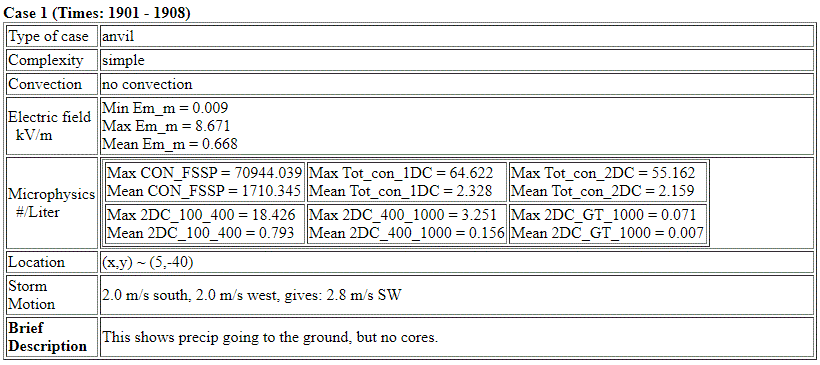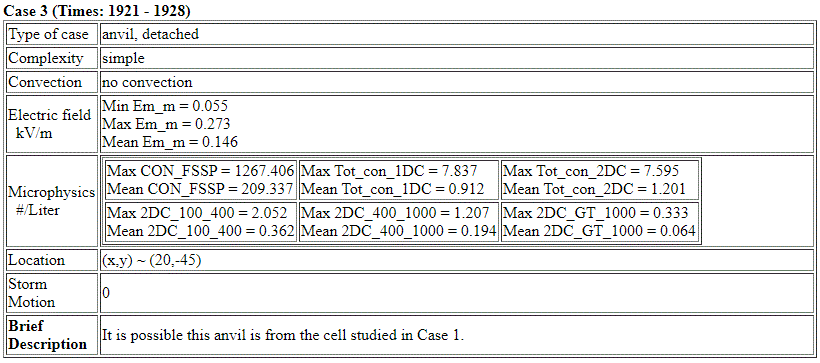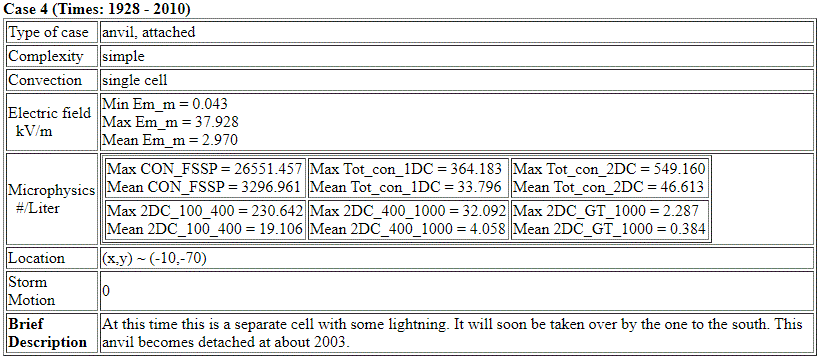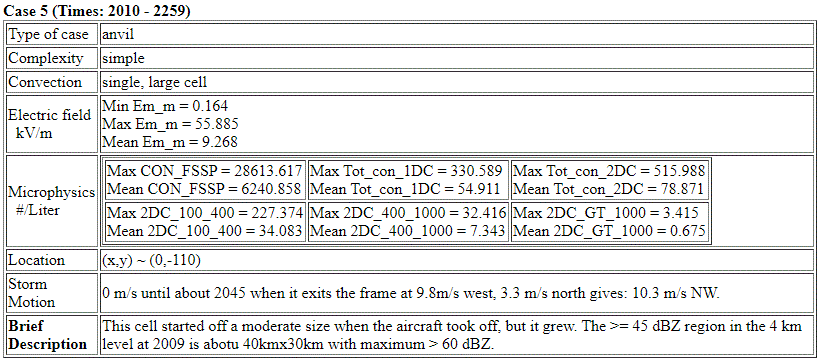Synthesis for June 4, 2001





There isn't a lot of motion in this system until about 2032 or 2045.
The aircraft arrives early in the development of this storm. It starts off as a line of small convective cells. The northern most cells deminish while the southern most cell gets so large that it eventually becomes the only thing there.
There is quite a lot of lightning associated with the cell. At about 2104 - 2135 there appears to be lightning out in the anvil.
Summary for June 4, 2001
Investigator: (Jim Dye, Geoff Dix)
Description: CASE 1: (1901 - 2259)
The first storm worked by the Citation first gave radar return at 7 km between 1645 and 1700 near X,Y of -10,-20 to -35 and showed 3 cells close together. [RADAR LINK] [Click on 7 km only, then click on CAPPIS from 1644 to 2014 -- this shows the sequence from before first echo of CASE 1 to the beginning of the Citation penetrations near the core of CASE 3.] There was little movement of this cluster over the next hour or more. By 1715 the refelectivity at 7 km was slightly in excess of 40 dBZ. A fourth, stronger cell appeared on the south end of this cluster near 1800. The weakness and small area of these cells at 10km altitude suggest tops did not go much above 10km. What little anvil that appeared seemed to move to the ENE but most in the 7 to 10 km levels.
The first lightning occurred in these cells at 1710 and by 1800 approx. 15 flashes had occurred. [LIGHTNING Grid 1] [LIGHTNING Grid 2] We need to examine the LDAR and CGLSS with better time and spatial resolution to determine the time of the last flash in this cluster of cells, but it appears that it might be near 1815.
The Citation took off at 1848 and flew chaotic patterns thru the debris and poorly formed anvil until about 1900 when it moved to the 2nd case. The E field during this first case was very weak except near 1907 when the A/C flew near somewhat higher reflectivity of ~20 dBZ. [MER Applet] Althought the A/C was in weaker reflectivity than 10 dBZ there was ~20dBZ within 5 to 10 km. This example shows the importance of looking at reflectivity not only at the A/C location, but also nearby.
CASE 2
Near 1900 a new stronger cell(s) appeared at X,Y=-1-,-75 with 54 dBZ at 7 km at 1900. The first small cell was probably present by 1845. From 1915 to 1930 it weakens but still has reflectivity of 40 to 45 dBZ at 7km. Because of spoking of the LDAR VHF sources it is hard to tell the time of the first lightning, but it was clearly active with CG flashes by 1900. The lightning from this cell is melded with flashed from the early cells to the north and makes it hard to distinquish which cell had what lightning.
The Citation moved to this cell at 1930 making it's first pass N to S near reflectivities of 20 to 30 dBZ. E fields on this pass were 30 to 40 kV/m. LINK MER 1937 The Citation made a 270 degr. loop and then proceeded East along the anvil which was moving directly E at 7 km, but the pass was on the southern edge so the E fields were not as large as near the cores. The measured E fields decreased with time, but the A/C did not pass through the higher reflectivities (~10-20 dBZ) so it's hard to know if strong E fields existed. During this case there is a good association between strong E field and larger reflectivity.
Near 2000 the A/C started towards the big complex of very strong cells which had moved/propagated north from Lake Ochochobee. This complex produce the long, long-lived anvil which was presented for CASE 3.
Summary

Instruments

HTML page with regrouped plots: 25 June 2001



